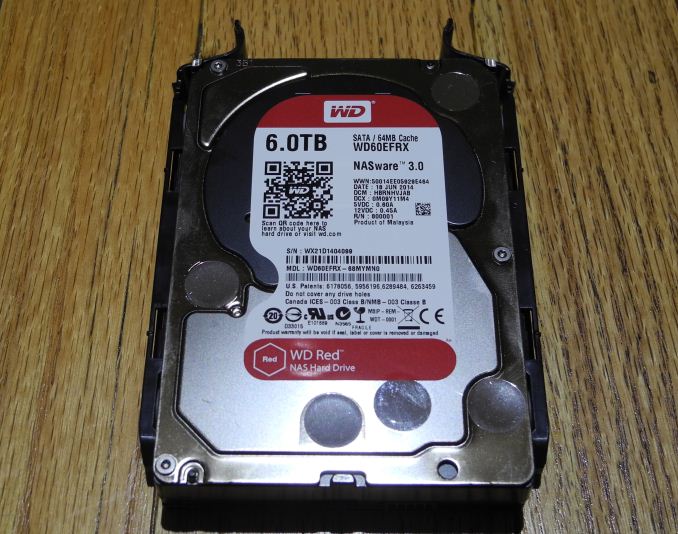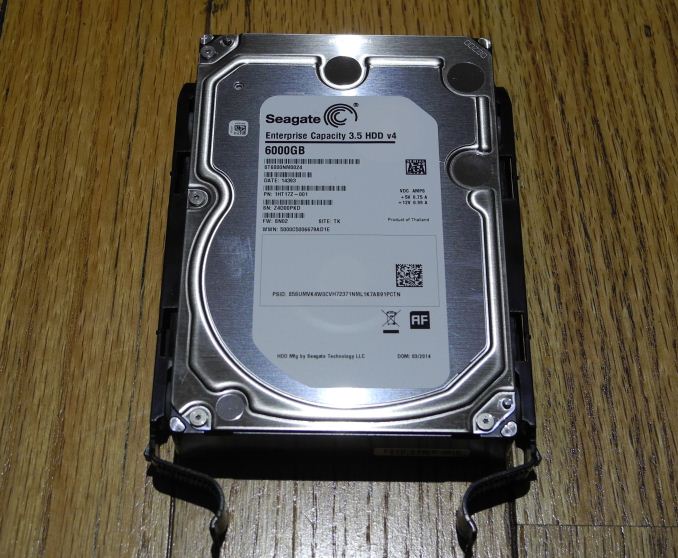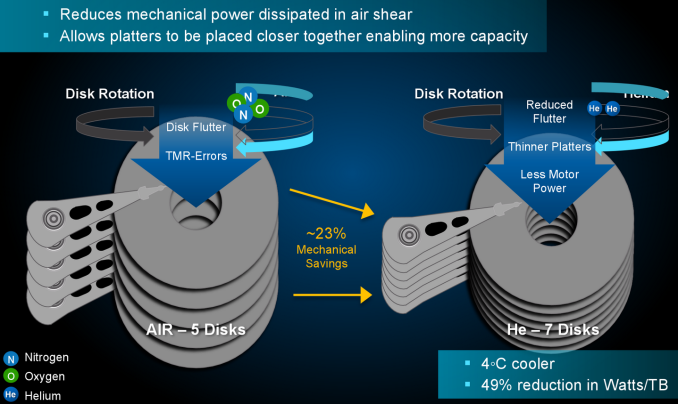6 TB NAS Drives: WD Red, Seagate Enterprise Capacity and HGST Ultrastar He6 Face-Off
by Ganesh T S on July 21, 2014 11:00 AM EST6 TB Face-Off: The Contenders
Prior to getting into the performance evaluation, we will take a look at the special aspects and compare the specifications of the three drives being considered today.
Western Digital Red 6 TB
The 6 TB Red's claim to fame is undoubtedly its areal density. While Seagate went in for a six-platter design for its 6 TB drives, Western Digital has managed to cram in 1.2 TB/platter and deliver a 6 TB drive with the traditional five platter design. The costs are also kept reasonable because of the use of traditional PMR (perpendicular magnetic recording) in these drives.
The 6 TB drive has a suggested retail price of $299, making it the cheapest of all the three drives that we are considering today.
Seagate Enterprise Capacity 3.5 HDD v4 6 TB
Seagate was the first to utilize PMR to deliver a 6 TB enterprise drive earlier this year. They achieved this through the use of a six platters (compared to the traditional five that most hard drives use at the maximum). A downside of using six platters was that the center screw locations on either side got shifted, rendering some drive caddies unable to hold them properly. However, we had no such issues when trying to use the QNAP rackmount's drive caddy with the Seagate drive.
Seagate claims best in class performance, and we will be verifying those claims in the course of this review. Pricing ranges from around $450 on Amazon (third party seller) to $560 on Newegg.
HGST Ultrastar He6 6 TB
The HGST Ultrastar He6 is undoubtedly the most technologically advanced drive that we are evaluating today. There are two main patented innovations behind the Ultrastar He6, HelioSeal and 7Stac. The former refers to placement of the platters in a hermetically sealed enclosure filled with helium instead of air. The latter refers to packaging of seven platters in the same 1" high form factor of traditional 3.5" drives.
With traditional designs, we have seen a maximum of six platters in a standard 3.5" drive. The additional platter is made possible in helium filled drives because the absence of air shear reduces flutter and allows for thinner platters. The motor power needed to achieve the same rotation speeds is also reduced, thereby lowering total power dissipation. The hermetically sealed nature of the drives also allows for immersive cooling solutions (placement of the drives in a non-conducting liquid). This is something not possible in traditional hard drives due to the presence of a breather port.
The TCO (total cost of ownership) is bound to be much lower for the Ultrastar He6 compared to other 6 TB drives when large scale datacenter applications are considered (due to lower power consumption, cooling costs etc.). The main issue, from the perspective of the SOHOs / home consumers, is the absence of a tier-one e-tailer carrying these drives. We do see third party sellers on Amazon supplying these drives for around $470.
Specifications
The various characteristics / paper specifications of the drives under consideration are available in the table below.
| 6 TB NAS Hard Drive Face-Off Contenders | |||
| WD Red | Seagate Enterprice Capacity 3.5" HDD v4 | HGST Ultrastar He6 | |
| Model Number | WD60EFRX | ST6000NM0024 | HUS726060ALA640 |
| Interface | SATA 6 Gbps | SATA 6 Gbps | SATA 6 Gbps |
| Advanced Format (AF) | Yes | Yes | No (512n) |
| Rotational Speed | IntelliPower (5400 rpm) | 7200 rpm | 7200 rpm |
| Cache | 64 MB | 128 MB | 64 MB |
| Rated Load / Unload Cycles | 300K | 600K | 600K |
| Non-Recoverable Read Errors / Bits Read | 1 per 10E14 | 1 per 10E15 | 1 per 10E15 |
| MTBF | 1M | 1.4 M | 2M |
| Rated Workload | ~120 - 150 TB/yr | < 550 TB/yr | < 550 TB/yr |
| Operating Temperature Range | 0 - 70 C | 5 - 60 C | 5 - 60 C |
| Physical Dimensions | 101.85 mm x 147 mm x 26.1 mm. / 680 grams | 101.85 mm x 147 mm x 26.1 mm / 780 grams | 101.6 mm x 147 mm x 26.1 mm / 640 grams |
| Warranty | 3 years | 5 years | 5 years |
The interesting aspects are highlighted above. Most of these are related to the non-enterprise nature of the WD Red. However, two aspects that stand out are the multi-segmented 128 MB cache in the Seagate drive and the HGST He6 drive's lower weight despite having more platters than the other two drives.













83 Comments
View All Comments
Wixman666 - Tuesday, July 22, 2014 - link
The WD Green and other drives fail more often because they are not intended for NAS use. They lack the anti-vibration mechanism, so they shake apart.anandtech_user01 - Monday, July 21, 2014 - link
Given my own previous experiences, I wouldn't trust high density 3.5" drives from any manufacturer period. Of course, lots of other people do (or somehow feel forced to). As for WD RED, they can be better than the competition in respect to being able to switch off the head-parking every 10 seconds (with wdidle3.exe DOS utility). Wheras I've got 2 Seagate Momentus 7200.2/4 and that's impossible with them. Looking at the specs for the 2.5" RED it's pretty much just a re-branded WD Black from the previous year. And those ones have been out for a few years, and are reliable / do have a good reputation. Wheras I've heard that the 3.5" RED something more like a re-worked / tweaked 3.5" WD Green. Not so sure about those ones.kmi187 - Monday, July 21, 2014 - link
Anecdotal evidence, while it should not be discarded, is rather irrelevant since the scale is rather low. Now if you look at some statistics from data-centers it shows seagate as a clear winner when it come to failure rates. In other words, they aren't doing too well.This data is much more reliable since it's data from a lot of hard drives, so it paints a much clearer picture.
I build custom pc's for a computer store and it's just not fun when you have kickass system that went out the door and 2 months later you have to tell the client, yeah sorry man but the drive died, we are going to have to reinstall your pc. If that starts to happen on regular basis, you know you have to look for alternatives.
romrunning - Monday, July 21, 2014 - link
Why wouldn't you build w/SSDs as your base drive, and only use spinning disks as secondary storage? It would seem that you would have better reliability that way.asmian - Monday, July 21, 2014 - link
Agree! It clearly isn't a "kickass" custom system if there's no SSD as boot drive. I pity these customers if they are being sold something as "special" without that as a basic building block these days. :( Please tell us where you work so we can avoid your store.erple2 - Tuesday, July 22, 2014 - link
Because managing two disks is a total waste of time and resources. If you're already going to a shop to have a machine built for you, then you've realized that your time is worth more to you than the inconvenience or rolling your own machine. Therefore, it stands to reason that you would also not want to be bothered with having to juggle installations to ssd vs. HDD. I have a setup like that in a laptop, and I hate having to figure out what applications I should put on the ssd vs the HDD. Just give me something that works. That and my time is worth far more than the cost spent trying to juggle applications on and off the ssd when it fills up.That having been said, ssd is pretty cheap now, so I'm not sure why you wouldn't put in a 500 gb to 1 tb ssd in a higher end build.
Samus - Monday, July 21, 2014 - link
I actually haven't had a drive from Seagate, WD or Hitachi fail in years. The last one was a 7200.10 1.5TB (~2008)I have more WD Red's in deployment than any other drive and they've all been great. However, the largest capacity I've rolled out are 2TB models.
iLovefloss - Monday, July 21, 2014 - link
Their older Barracuda drivers sure did.http://blog.backblaze.com/2014/01/21/what-hard-dri...
Of course, they gotten better.
http://www.hardware.fr/articles/920-6/disques-durs...
Still, no matter how you look at it, those "Green" drives tend to fail more often than their other counterparts.
cm2187 - Tuesday, July 22, 2014 - link
Same here. A bunch of 4TB Red and never managed to make them work in a hardware RAID array (LSI and Adaptec). Same symptoms as in the article. Drive marked as failed in the array but works well as standalone. Still had some problems though much less in a soft array (synology). Hitachi desktop drives behave much better in a hardware RAID.LoneWolf15 - Friday, July 25, 2014 - link
I've been running Reds (mix of 2TB and 3TB, as I'm slowly migrating capacity) in an HP SmartArray P222 in an HP Microserver Gen8 for some time now. 6TB RAID-5 array and no failures.I will admit, I haven't tried the 4TB models for RAID, but do have one in a USB3 MacAlly external enclosure for backing up the box (Server 2012R2 Standard).